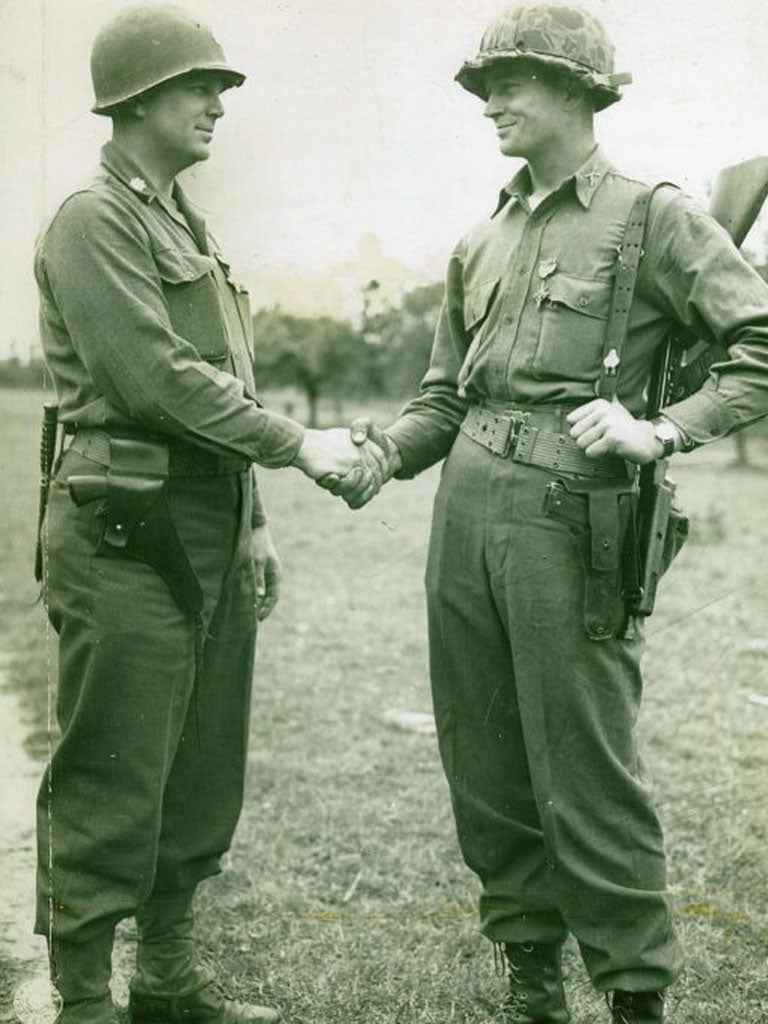Lieutenant George Kerchner: Veteran of the D-Day landings
Injured later, he wrote in his diary, 'Attack. Rough! Got hit. Million dollar wound.On way back'

The US army Ranger Lieutenant George Kerchner was one of the first men to scale the German-held 100-feet cliffs at Pointe du Hoc, Normandy, during the first minutes of the D-Day landings. Their mission was to destroy a battery of heavy artillery guns which, with their range of 15 miles, threatened the entire success of D-Day. Kerchner and his comrades from the US army's 2nd Ranger Battalion climbed hand-over-hand on ropes or used rope ladders attached to grapnel hooks fired by rockets from their landing craft. All the while, the German defenders were trying to slash their ropes, firing on them and dropping grenades which, Kerchner later recalled, "caused us some annoyance."
Less than two hours after leaping from British-crewed landing craft under heavy gunfire, the Rangers had completed their mission – to take out five 155mm artillery pieces aimed at allied troops on the beaches below codenamed Utah and Omaha. They were the first allied soldiers to complete their Normandy mission, albeit for the loss – dead or badly wounded – of 135 of their 225 men. For his actions, Kerchner was awarded the Distinguished Service Cross for "extraordinary heroism." The assault on Pointe du Hoc was featured in the 1962 Hollywood blockbuster The Longest Day, although the Rangers felt it did not do them justice because it did not show them completing their mission. The exploits of Kerchner's D (Dog) Company also figure prominently in the popular video game Call of Duty 2.
For six months before D-Day, he and his 2nd Ranger Battalion had trained on the cliffs around Bude, Cornwall, at Swanage in Dorset, Morte Bay in Devon and on the Isle of Wight for what seemed almost like a suicide mission. When his men were told their task, their commanding officer Lt-Col James Earl Rudder's initial, though brief, reaction was reportedly to laugh, while a US army intelligence officer in the room interjected: "It can't be done. Three old women with brooms could keep the Rangers from climbing that cliff."
After marching through Weymouth, Dorset, in early June 1944 to the cheers of locals and with Lt-Col Rudder at their head, the US Rangers sailed out ofPortland Harbour – soon, 68 years on, to be the site of a more peaceful event, the Olympic sailing. The Rangers,modelled on Churchill's first British commandos and later to inspire US Special Forces and Navy Seals, later assembled on the deck of HMS Ben Machree, a former Channel steamer, before dawn on D-Day.
They jumped on to British-manned LCAs (Landing Craft Assault), around 22 men to a craft, Kerchner on board LCA 668. Later to become knownas Rudder's Rangers, they had beendue to land at H-Hour – 06.30 French time – but, due to poor weather conditions and navigational errors, hit the beach at 07.08.
Before he leapt ashore, Kerchner recalled the battalion's padre, Joe Lacy (himself decorated for bravery), saying during a last-minute mass: "When you get on that beach, I don't want to see anybody kneeling down and praying. If you do, I'm gonna come up and boot you in the tail. You leave the praying to me, and you do the fighting."
Hitting the beach, Kerchner's first recollection was of seeing two of his officers fall to German machine-gun fire from his left. That put him in charge of D-Company. He himself fell into a shell crater in the water, losing his rifle in swirling surf. As in the 1998 Hollywood film Saving Private Ryan (in which the Tom Hanks character was an officer in the Rangers' 2nd Battalion who landed on Omaha Beach), Kerchner recalled the chaos and the deafening sound of German gunfire and bombardment of the cliffs from British and US warships aimed at giving his men cover.
"My first impulse was to go after this machine gun up there, but I immediately realised this was rather stupid,as our mission was to get to the top of that cliff and get on with destroying those guns," he said. After using ropes and rope ladders, he and his men were aided by extendable lightweight ladders they had requisitioned from the London fire brigade.
Kerchner was one of the first dozen men who stormed over the clifftop within 10 minutes of hitting the beach, driving back German infantrymen through terrain devastated by allied bombing and naval bombardment. To their chagrin, they found that their goal – six artillery gun casements – were empty. After Kerchner sent two men out on patrol, they found five unmanned 155m guns 1,000 metres inland, camouflaged in an apple orchard, and put them out of action using thermide (incendiary) grenades. Mission accomplished, less than two hours after coming ashore.
Kerchner himself, with 15 of his men, was cut off from the battalion for 60 hours, fighting off Germans, before they were relieved. Almost three months later, after the Rangers had been ordered west into Brittany, he was badly wounded in the shoulder on 1 September in the bloody battle for Hill 63 near the hamlet of Ty Baol.
In his wartime diary, he scribbled: "Attack. Rough! Got hit. Million dollar wound. On way back." It was the end of his war, although he continued to serve after the war in the Maryland National Guard, retiring with the rank of Lieutenant-Colonel. He also returned to the Arundel Ice Cream company in his native Baltimore, where he had started as a teenager in the 1930s as a "soda jerk" to help his family during the Great Depression. By the time he retired in the 1980s, he was Arundel's president and general manager.
George Francis Kerchner, soldier and business executive: born Baltimore, Maryland 22 February 1918; married 1939 Violet Schuneman (died 1989;four children), 1991 Kathryn (Kay) Fairchild: died Midlothian, Virginia 17 February 2012.
Join our commenting forum
Join thought-provoking conversations, follow other Independent readers and see their replies
Comments